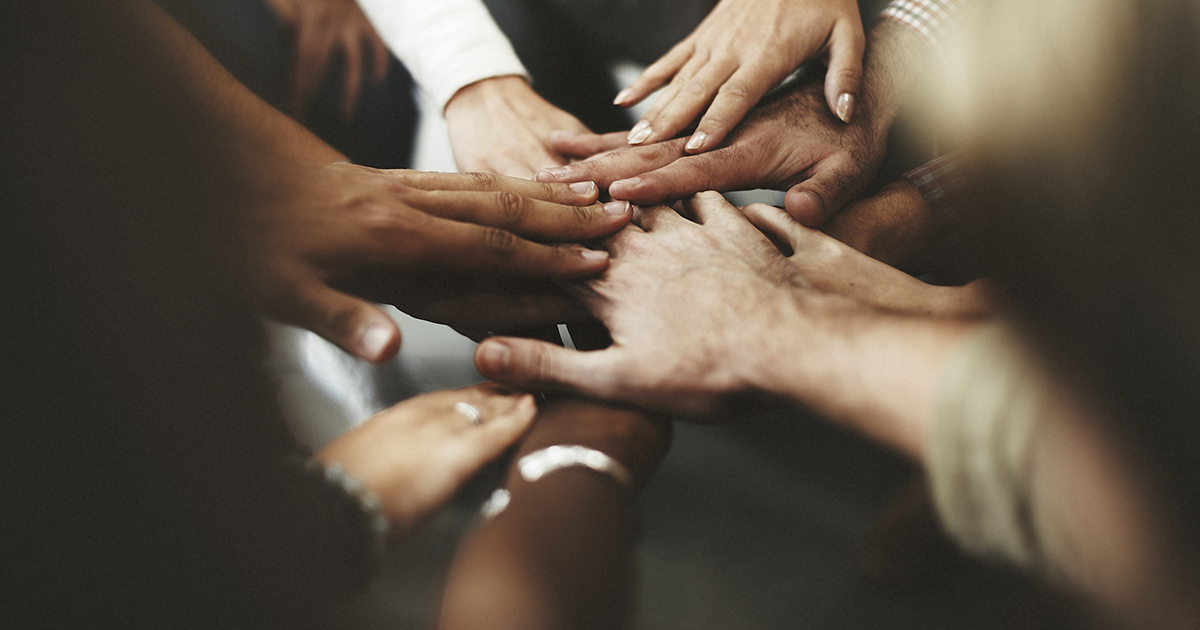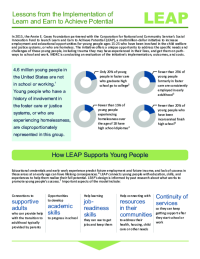Lessons from the Implementation of Learn and Earn to Achieve Potential (LEAP)

In 2015, the Annie E. Casey Foundation partnered with the Corporation for National and Community Service’s Social Innovation Fund to launch Learn and Earn to Achieve Potential (LEAP), a multimillion-dollar initiative to increase employment and educational opportunities for young people ages 15-25 who have been involved in the child welfare and justice systems, or who are homeless. The initiative offers a unique opportunity to address the specific needs and challenges of these young people, including trauma they may have experienced in their lives, and get them on pathways to school and work. MDRC is conducting an evaluation of the initiative’s implementation, outcomes, and costs.
|
How LEAP Supports Young People
|
Educational credentials and early work experience predict future employment and future income, and lack of success in these areas at an early age can have lifelong consequences.6 LEAP connects young people with education, skills, and experiences to help them realize their full potential. LEAP’s design is informed by past research about what works to promote young people’s success.7 Important aspects of the model include:
|
About LEAP Participants
|
|
About the LEAP Program Models
|
|
The LEAP Evaluation
|
MDRC’s evaluation will include a thorough look at the two models’ implementation and adaptation, an examination of the role of local systems in LEAP implementation and LEAP enhancements, an analysis of individual-level participation and outcome data, and in-depth interviews with participants. A final report will be released in 2019.
MDRC conducted a round of site visits to each program in 2017 to learn about implementation. Though each LEAP location has structured its local program differently, there were common ways that each is adapting the two LEAP models to promote and sustain the engagement of participants. Examples from selected sites highlight how these adaptations work in practice.
NOTES
1. Measure of America of the Social Science Research Council, “Disconnected Youth” (website: www.measureofamerica.org/disconnected-youth, 2018).
2. National Working Group on Foster Care and Education, “Fostering Success in Education: National Factsheet on the Educational Outcomes of Children in Foster Care,” Research Highlights on Education and Foster Care January 2014 (website: http://cdn.fc2success.org/wp-content/uploads/2012/05/National-Fact-Shee…, 2014).
3. U.S. Department of Health and Human Services, Coming of Age: Employment Outcomes for Youth Who Age Out of Foster Care Through Their Middle Twenties (website: https://aspe.hhs.gov/system/files/pdf/75376/report.pdf, 2008.)
4. D. Wayne Osgood, E. Michael Foster, and Mark E. Courtney, “Vulnerable Populations and the Transition to Adulthood” (The Future of Children 20, 1: 209-229, 2010).
5. Laura S. Abrams and Todd M. Franke, “Postsecondary Educational Engagement Among Formerly-Incarcerated Transition-Age Young Men” (Journal of Offender Rehabilitation 52, 4: 233-253, 2013).
6. Andrew Sum, Ishwar Khatiwada, and Joseph McLaughlin, with Sheila Palma, “The Consequences of Dropping out of High School: Joblessness and Jailing for High School Dropouts and the High Cost for Taxpayers” (Boston: Center for Labor Market Studies at Northeastern University, 2009).
7. Louisa Treskon, What Works for Disconnected Young People: A Scan of the Evidence (New York: MDRC, 2016); David Fein and Jill Hamadyk, Bridging the Opportunity Divide for Low-Income Youth: Implementation and Early Impacts of the Year Up Program, OPRE Report #2018-65 (Washington, DC: Office of Planning, Research, and Evaluation, Administration for Children and Families, U.S. Department of Health and Human Services, 2018); Cynthia Miller, Megan Millenky, Lisa Schwartz, Lisbeth Goble, and Jillian Stein, Building a Future: Interim Impact Findings from the YouthBuild Evaluation (New York: MDRC, 2016); Megan Millenky, Dan Bloom, Sara Muller-Ravett, and Joseph Broadus, Staying on Course: Three-Year Results of the National Guard Youth ChalleNGe Evaluation (New York: MDRC, 2011).
The LEAP evaluation is funded by the Annie E. Casey Foundation. For more information, visit www.mdrc.org/project/learn-and-earn-achieve-potential-leap.














